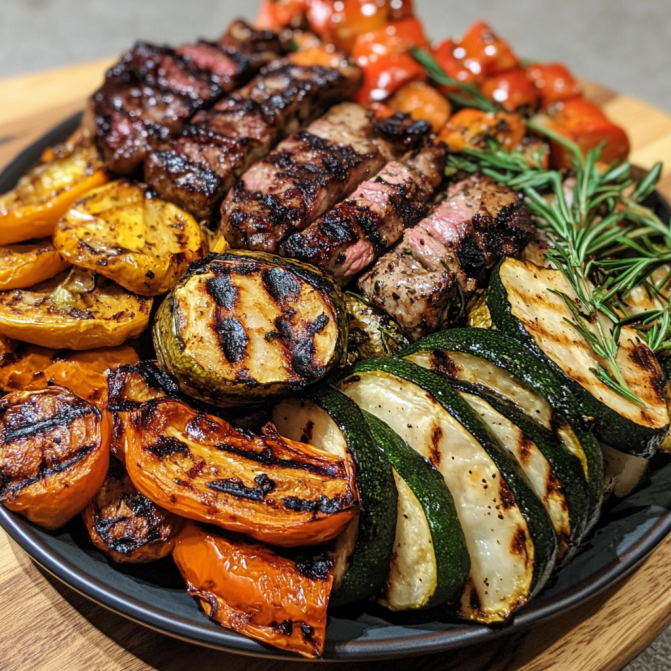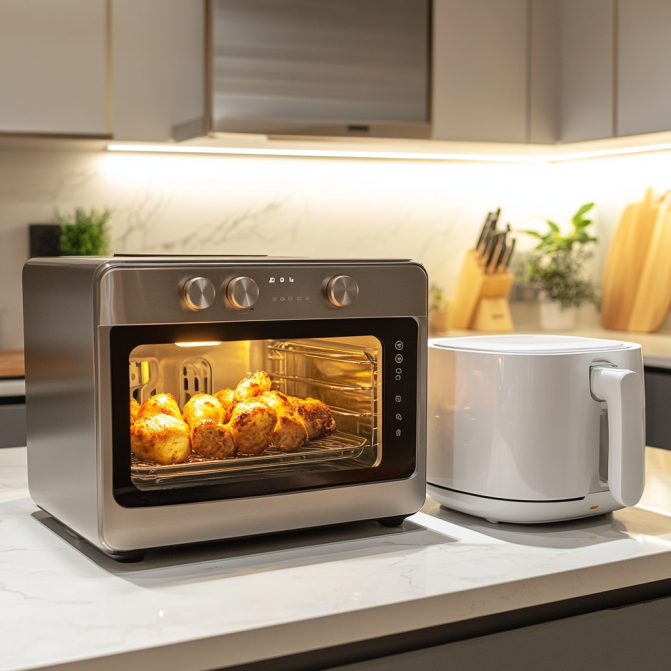Air Fryer Vs Oven: Which Is Better For Grilling?
Choosing the right cooking method can transform your meals, enhancing flavours and textures while considering health and convenience. We will explore the pros and cons of three popular cooking techniques: grilling, air frying, and oven cooking. Each method has its unique benefits and drawbacks, impacting everything from taste to preparation time. By comparing these options, you can discover which cooking style best fits your lifestyle and preferences, making mealtime a delightful experience.
Definitions and Differences
Understanding the definitions and differences between grilling, air frying, and oven cooking is essential for effective food preparation. Each cooking method employs distinct techniques and kitchen appliances, catering to a variety of culinary trends while offering diverse health benefits, energy efficiency, and flavour enhancement. Grilling typically involves outdoor cooking over an open flame, whereas air fryers provide a healthier alternative through rapid air circulation, and traditional ovens present versatility for baking and roasting. Grilling imparts a unique smoky flavour and facilitates the reduction of excess fat, making it a popular choice among health-conscious individuals. However, it may require constant supervision and can be less feasible in inclement weather conditions. Conversely, air frying utilises convection technology to achieve crispy textures with significantly less oil, making it an appealing option for those seeking to lower calorie intake. However, the size of the air fryer may restrict the preparation of larger meals. Traditional ovens excel in cooking larger quantities and can accommodate multiple dishes simultaneously; however, they often consume more energy and can increase the ambient temperature in the kitchen. Each method, while distinct, offers various advantages and disadvantages that cater to different cooking needs and preferences.
Pros and Cons of Grilling
Grilling presents a commendable cooking method, enhancing food with distinctive flavour profiles while offering the convenience of reduced cooking times. This technique is particularly favoured for outdoor dining, as the grill marks on meats and vegetables contribute to an appealing visual presentation. Nevertheless, grilling does entail specific challenges, such as difficulties in temperature regulation and the necessity for safety measures to address the risks associated with open flames.
Benefits and Drawbacks
The benefits of grilling encompass not only enhanced flavour but also promote health-conscious cooking by reducing fat content and improving energy efficiency. This method has become increasingly popular among culinary enthusiasts. The capacity to prepare a variety of meals infused with a distinctive smoky flavour significantly contributes to its appeal, all while upholding food quality and safety standards. This cooking technique facilitates the ideal caramelisation of meats and vegetables, thereby encouraging the use of fresh, wholesome ingredients. Moreover, grilling typically requires less oil, which can result in healthier meal options overall. However, individuals who engage in grilling may encounter challenges such as mastering temperature control and ensuring even cooking. Safety concerns, including flare-ups and the proper handling of raw meats, can dissuade some individuals from utilising this method. Upon evaluating these considerations, it is evident that while grilling provides delightful flavours and healthier alternatives, it also necessitates careful attention and skill.
Pros and Cons of Air Frying
Air frying has increasingly gained prominence due to its capability to produce a crispy texture in foods while substantially reducing fat content, thereby presenting a contemporary approach to healthy cooking. This countertop appliance provides exceptional convenience, facilitating quick meal preparation with minimal oil usage, making air frying a preferred method for individuals who prioritise health-conscious cooking.
Benefits and Drawbacks
The functionality of an air fryer offers numerous benefits, including rapid cooking times and energy efficiency, which are particularly advantageous for individuals with busy lifestyles. However, it is important to consider certain drawbacks, such as limited capacity and the necessity for regular maintenance to ensure optimal performance. By significantly reducing meal preparation times compared to traditional cooking methods, this kitchen appliance enables users to create delicious dishes in a fraction of the time, making it an excellent option for weekday dinners or impromptu gatherings. Additionally, energy consumption is minimised, which can contribute to lower utility bills over time. Conversely, individuals contemplating the adoption of an air fryer should be aware that these devices can be somewhat noisy during operation, potentially causing disruptions within the household. Moreover, the cleaning process may be somewhat cumbersome, as it requires users to regularly attend to the basket and other components in order to maintain the appliance in optimal condition.
Owala FreeSip Insulated Stainless Steel Water Bottle with Straw for Sports and Travel, BPA-Free, 24-oz, Blue/Teal (Denim)
$27.99 (as of 21:45 GMT +00:00 - More info)Pros and Cons of Oven Cooking
Oven cooking is a traditional method celebrated for its versatility, as it accommodates a range of cooking styles, including baking, roasting, and grilling. This makes it an essential kitchen appliance for numerous households. With its precise temperature control and capability to prepare meals for families, the oven provides both functionality and reliability; however, it is important to note that it may require longer cooking times compared to alternative cooking methods.
Benefits and Drawbacks
The advantages of oven cooking include superior food quality and user-friendliness, offering straightforward meal preparation options with minimal hands-on involvement. However, the extended cooking times and the requirement for preheating may be considered drawbacks when compared to quicker cooking methods, such as air frying. Utilising an oven allows for the attainment of a desirable crispy texture and the development of rich flavours in baked goods, which are often difficult to achieve through alternative cooking methods. The even heat distribution of an oven ensures consistent results, particularly when roasting vegetables or baking pastries. Nevertheless, this appliance necessitates regular maintenance and cleaning, especially after preparing dishes with high moisture content, which can be cumbersome. Furthermore, cooking in an oven may lead to increased energy consumption, resulting in higher utility bills over time. Therefore, while oven cooking offers numerous benefits for culinary enthusiasts, the time investment and maintenance requirements are critical factors to consider.
Comparing Cooking Methods
When comparing various cooking methods, it is essential to assess factors such as cooking efficiency, energy consumption, meal variety, and user experiences. Grilling, air frying, and oven cooking each offer distinct advantages and disadvantages, necessitating a comprehensive evaluation to identify the most suitable option for individual cooking preferences and dietary requirements.
Factors to Consider
Selecting the appropriate cooking method necessitates careful consideration of various factors, including personal preferences, convenience, safety features, and maintenance requirements. Each method ranging from grilling to air frying to oven cooking offers unique advantages. Understanding how these methods align with one s lifestyle is crucial for making an informed decision. In evaluating these cooking techniques, it is important to assess the cooking surface, as certain materials conduct heat more efficiently, influencing both cooking times and the overall quality of the food. Furthermore, ingredient preparation plays a significant role; for example, specific methods may require marinating or chopping, which can impact the final taste and texture of the dish. Safety features, such as automatic shut-off mechanisms and sturdy handles, should be given due consideration, particularly for individuals with children or pets in the household. By taking these factors into account, individuals can identify a cooking method that not only meets their culinary preferences but also aligns with their cooking habits and safety requirements.
Which Method is Best for You?
Determining the most suitable cooking method for one s needs is contingent upon personal preferences, family meal dynamics, and meal planning considerations. Whether the focus is on convenience, cooking efficiency, or flavour, a comprehensive understanding of the distinct advantages associated with grilling, air frying, and oven cooking will assist in selecting the most appropriate method for culinary pursuits.
Personal Preferences and Considerations
Personal preferences significantly influence the selection of a cooking method, particularly when considering the variety of recipes and health-conscious cooking. For individuals who appreciate exploring ingredient versatility, air frying may offer a more appealing option, whereas grilling is well-suited for outdoor gatherings and enhancing flavour. Techniques such as steaming are particularly advantageous for those focused on nutrient retention, making them an excellent choice for health enthusiasts. On the other hand, slow cooking provides a remarkable solution for busy individuals, enabling them to prepare hearty, warm meals with minimal effort, all while intensifying flavours over time. It is essential to consider the needs of a family that prioritises convenience compared to an individual seeking gourmet experiences; each cooking method presents tailored advantages. Therefore, understanding which method aligns with one s cooking style not only simplifies meal preparation but also enriches the overall culinary experience.










